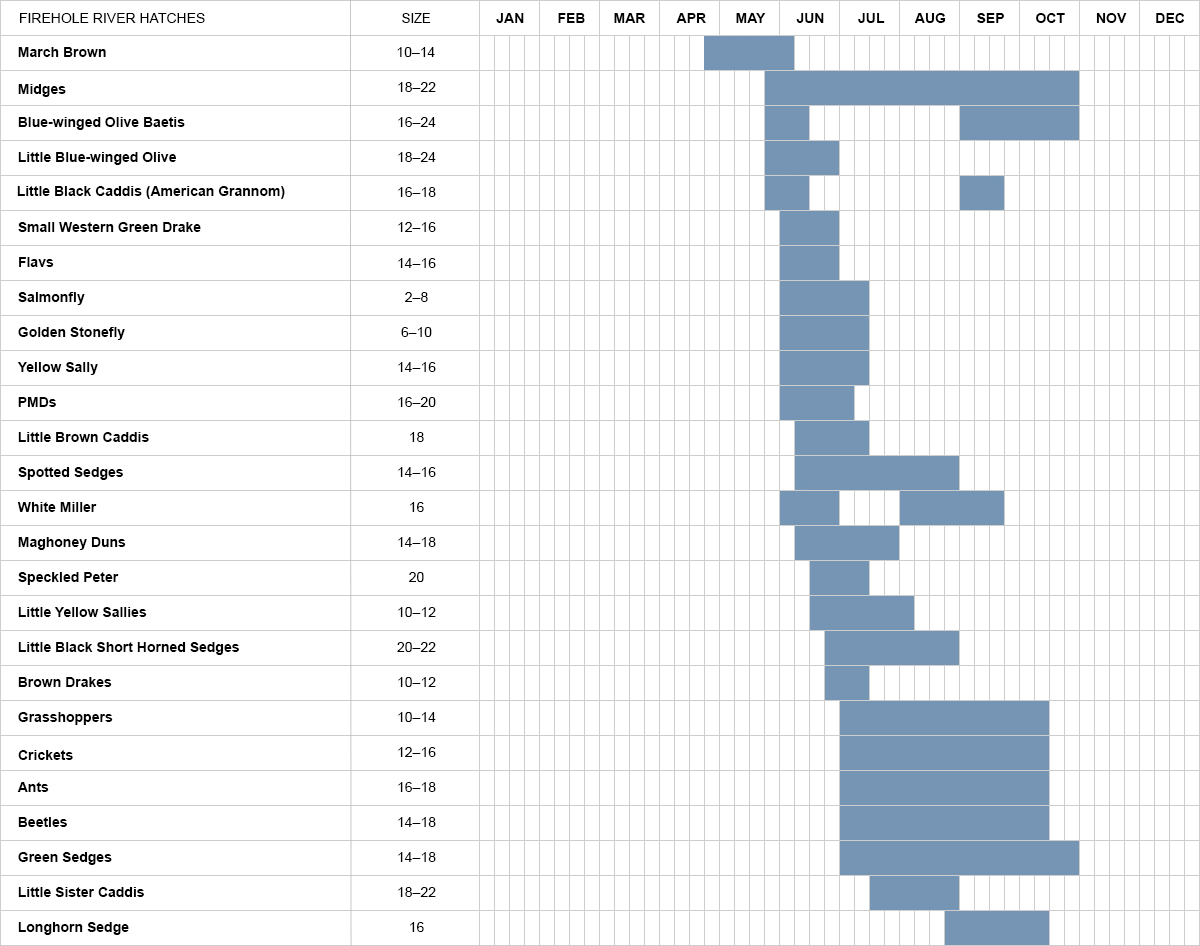A robust and diverse population of aquatic insects and fly hatches makes Firehole River one of the most productive dry fly trout fishing rivers in the United States.

The following chart lists the most important hatches that anglers should plan for to when fishing the Firehole River. Fly sizes and hatches date will vary by river section and conditions.
| Fly Hatch | Size | Date |
|---|---|---|
| March Brown | 10–14 | Apr 20 - June 5 |
| Midges | 18–22 | May 20 - Oct 31 |
| Blue-winged Olive (Baetis) | 16–24 | May 20 - June 15; Sep 1 - Oct 31 |
| Little Blue-winged Olive | 18–24 | May 20 - June 30; Sep 1 - Oct 31 |
| Little Black Caddis (American Grannom) | 16–18 | May 25 - June 15; Sep 1 - Sep 20 |
| Small Western Green Drake | 12–16 | June 1 - June 30 |
| Flavs | 14–16 | June 1 - June 30 |
| Salmonfly | 2–8 | June 1 - July 15 |
| Golden Stonefly | 6–10 | June 1 - July 15 |
| Yellow Sally | 14–16 | June 1 - July 15 |
| PMDs | 16–20 | June 1 - July 10 |
| Little Brown Caddis | 18 | June 5 - July 15 |
| Spotted Sedges | 14–16 | June 5 - Aug 31 |
| White Miller | 16 | June; Aug 1 - Sept 20 |
| Maghoney Duns | 14–18 | June 10 - July 31 |
| Speckled Peter | 20 | June 15 - July 15 |
| Little Yellow Sallies | 10–12 | June 15 - Aug 5 |
| Little Black Short Horned Sedges | 20–22 | June 20 - Aug 31 |
| Brown Drakes | 10–12 | June 25 - July 15 |
| Grasshoppers | 10–14 | July 1 - Oct 15 |
| Crickets | 12–16 | July 1 - Oct 15 |
| Ants | 16–18 | July 1 - Oct 15 |
| Beetles | 14–18 | July 1 - Oct 15 |
| Green Sedges | 14–18 | July 1 - Oct 31 |
| Little Sister Caddis | 18–22 | July 15 - Aug 31 |
| Longhorn Sedge | 16 | Aug 20 - Oct 15 |
Major Firehole River Hatches
The first major fly hatches of the year on Firehole River will be midges followed by Blue Winged Olives (BWOs). Midge hatches get underway as early as late April and continue through early June. BWO hatches appear in late May and continue through mid June, reappearing in early fall. A simple #14-16 Parachute Adams is your go-to fly for fishing both of these hatches.
As weather warms in June, attention turns to Pale Morning Dun (PMD) mayfly and caddis hatches as the river comes to life with aquatic insects. PMD hatches are hot and heavy from the bigging of June through mid July. Caddis hatches get under way in June as well and linger throughout the summer. A size #16-18 cripple pattern or PMD imitation fly is effective for fishing the PMD hatch.
The most important caddis fly to pay attention to is the White Miller. This large, cream-colored insect is a trout delicacy. During early afternoons you’ll see trout breaking the surface to get a mouthful of this delectable fly. A #10-12 White Miller pattern that floats is your go-to fly to match the hatch. You can pick up this fly at a local fly shop or pre order online.
June ushers in another important fly hatch, Yellow Sally stoneflies. Yellow sally hatches peak during the month of June and linger through July and into August some years. Terrestrials enter the fray beginning of July and every angler should carry a good supply of ant, beetle and hopper patterns sizes #10-18.
Caddis hatches reappear in force as soon as the cool weather hits in September. Moving into late fall, early winter as temperatures plummet, and snow moves in, BWO and midge hatches again take center stage. During spring and fall anglers should be prepared with an array of patterns to target caddis, BWO and midge hatches. Downsize your fly size for fall fishing.
On the Firehole River, a slight change in temperature or cloud cover from one day to the next can change the predominant hatch on the water. One of the most effective presentations for fly fishing Firestone River is an emerger patterned fished behind a dry fly.



